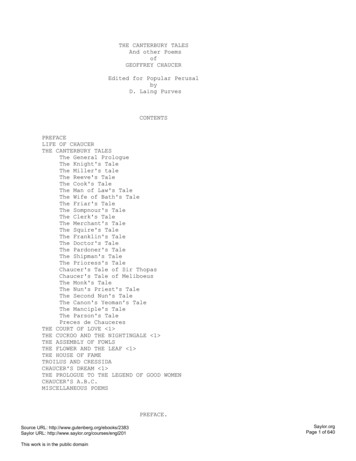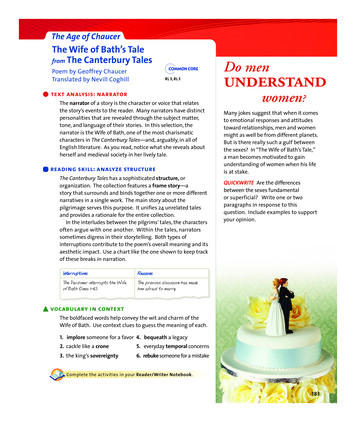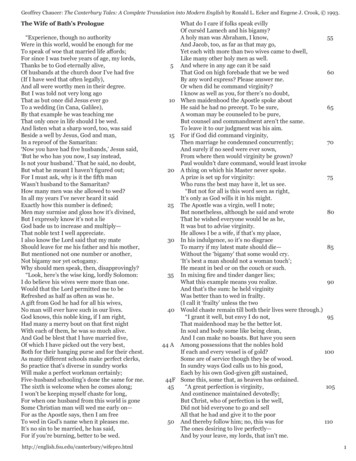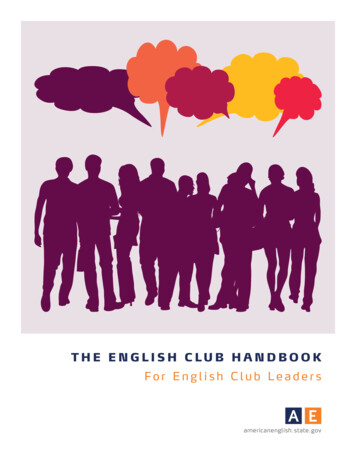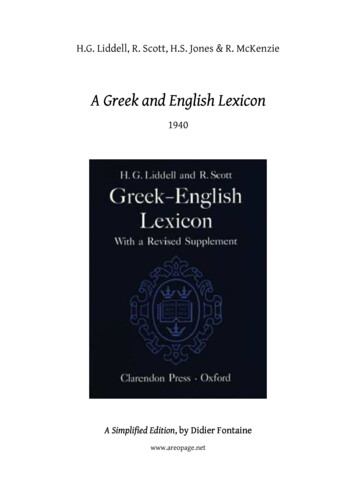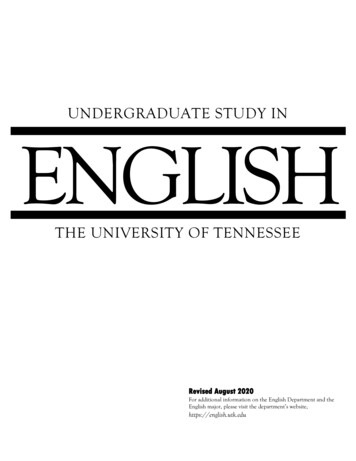
Transcription
Reference: Chaucer’s Middle EnglishChaucer’s Middle EnglishSimon Horobin (simon.horobin@magd.ox.ac.uk)A reference chapter from The Open Access Companion to theCanterbury Tales (September 2017)VarietyThe history of the English language is traditionally divided into the following periods: OldEnglish (650-1100), Middle English (1100-1500), Early Modern English (1500-1800), LateModern English (1800-present day) (for a general overview see Horobin 2016). To a modernreader turning to Chaucer’s work for the first time, the immediate impression is of considerablelinguistic chaos and confusion. This is especially true for modern readers accustomed to theworld of Standard English and the fixity of the printed book. But, where Chaucer’s languagemay at first appear disordered, much of its apparent irregularity can be explained by reference tothe language’s historical development. As the term “Middle” English implies, the period inwhich Chaucer wrote was one of considerable flux and change, in which the Old English spokenby the Anglo-Saxons (a language that resembles Modern German more closely than it doesModern English) was transformed into Early Modern English—a term that emphasizes itsposition as the foundation of the language spoken throughout the world today.Chaucer wrote during the final decades of the fourteenth century; hence, his language belongs tothe later Middle English period. An important feature of the division between the Middle and theEarly Modern periods was the emergence of a standard written variety of English. While dialectvariation has been a feature of spoken English throughout its history, the Middle English periodwas characterised by considerable variety in writing too. So, where Modern English has just oneway of spelling most words (setting aside the small number of variants between US and BritishEnglish, such as color and colour), there were numerous ways of spelling common words inMiddle English. The word not, for instance, might appear as nat, noght, nawt, naught, naȝt andmany other similar forms. It is because of this dialectal variation that reading Chaucer’s MiddleEnglish is quite a different experience from reading the works of his contemporaries, such asPiers Plowman and Sir Gawain and the Green Knight, which were both written in dialects of theWest Midlands. Since he was a Londoner by birth, Chaucer’s works are written in the dialect ofthat city. The prominence of the city of London meant that it formed the basis of the standardlanguage, but this was a later, fifteenth-century, development. In Chaucer’s day, London Englishcarried no greater status than any other dialect.As in many modern cities, the language spoken on the streets of Chaucer’s London wascharacterized by considerable diversity—the result of large-scale immigration into the capitalduring the fourteenth century. Although it is historically an East Midland dialect, London
English of this period was influenced by a variety of non-metropolitan dialects, as speakers fromdifferent parts of the country migrated to London in search of work. During the early part of thefourteenth century, immigration was greatest from East Anglia; in the second half of thatcentury, it was focused more on the Central and North Midlands. The result was a linguisticmelting pot; where Modern English is characterized by standardization and regularity, Chaucer’sMiddle English was dynamic and unregulated.Since the eighteenth century, writers have sought to stabilize and regulate the English language;variation and change were seen as disruptive and hostile to serious literary endeavor. However,variation in spelling, grammar, and pronunciation can be of considerable use to a poet, and thereare many instances in Chaucer’s works where he draws upon this licensed variation where rhymeor meter demands it. Let’s take the adjective merry as an example. In Old English, this word wasspelled myrige; in Middle English, alternative pronunciations emerged in the different dialectareas—mury (West Midlands), miry (East Midlands), mery (East Anglia and the South-East). InLondon, because of immigration, all of these pronunciations were available; Chaucer made useof this variation in rhyme: merye appears at GP 208 where it rhymes with berye; at GP 802, it isspelled mury in order to rhyme with Canterbury; and at Merchant’s Tale 2326, it is mirye, torhyme with pirie [“pear tree.”]VocabularyThe variety that we have seen in Chaucer’s dialect is also found in his vocabulary. The MiddleEnglish wordstock (or “lexicon”) was made up of words from various sources. Core items,including grammatical words like conjunctions (and, but) and pronouns (I, you, him), wereinherited from the Old English language spoken by the Anglo-Saxons. During the MiddleEnglish period, English was heavily influenced by the French spoken by the aristocratic Normaninvaders. Because French was also the language of courtly literature and fashionable manners,much of the vocabulary of polite discourse and behavior was drawn from French: for example,curteis, debonair, gentil, noble. Latin was another important source, especially in the area ofreligious writing, as Latin was the language of the Church and the Bible—hence words likescripture and monasterie. Middle English also included a number of words borrowed from theOld Norse language spoken by the Vikings who invaded Britain during the Anglo-Saxon period,although, since the Viking settlements were in the North and East Midlands, Norse words weremore prominent in the dialects of those regions than in London English. The structuralsimilarities between English and Norse (both are Germanic languages) combined with thetendency for Vikings to settle among and intermarry with Anglo-Saxons promoted borrowing ofmore everyday words from Old Norse; egg, husband, window, take, leg give a flavor.GrammarLike other modern Germanic languages, Old English was a highly synthetic language; this meansthat it relied heavily upon special endings to indicate the relationships between words in asentence. By comparison, Modern English makes comparatively little use of such inflexions,beyond the -‘s ending to mark possession and the -s ending to indicate when a noun is plural. Bythe later Middle English period in which Chaucer wrote, many of the grammatical inflexions thatcharacterized the Old English period had already fallen out of use. The only noun endings that
survive into Chaucer’s dialect are the -(e)s ending that indicates possession and the -(e)s endingthat is added to a noun to signal when it is plural. There are, however, a handful of nouns thatpreserve an alternative Old English -n plural ending (found today in ox–oxen)—for example,toon (toes) and shoon (shoes)—but these often appear alongside equivalents with the much morefrequent -s. One further relic of the Old English inflexional system is preserved in certain setphrases, where an -e ending appears on nouns following prepositions (indicating the “dative”case): for example, in toune, on honde.The decay of the Old English inflexional system also affected Middle English adjectives,although in Chaucer’s usage an -e ending continued to be added to adjectives when theymodified a plural noun: for example, olde men. When preceded by a determiner—such as thedefinite article the or the demonstratives this or that—singular monosyllabic adjectives also tookan -e ending: the olde man. These distinctions were rather old fashioned by the late fourteenthcentury and had probably ceased to be a part of the spoken language. For Chaucer, they were auseful metrical device because they provided an unstressed syllable between two stressedsyllables.PronounsThe Middle English pronoun system is similar to that of Modern English; it differed from that ofOld English in the replacement of the earlier third person plural pronouns with ones borrowedfrom Old Norse—the ancestor of Modern English they, their, them—which were adopted asreplacements for the Old English equivalents hie/hi, hira, him, which were easily confusablewith other pronouns. As with other words borrowed from Old Norse, the third person pluralpronouns were adopted earliest in the Northern and East Midland dialects, only filtering downinto London usage in the fourteenth century. Chaucer’s pronoun system shows a mixedparadigm; he used the Old Norse form for the nominative pronoun they but Old English derivedhir/her and hem. The only appearances of their and them in Chaucer’s works are in the Reeve’sTale, where they form part of the Northern dialect spoken by the two Cambridge students, Aleynand John, demonstrating that at this time they were still perceived to be Northernisms.Among the differences between the Middle English pronoun system and that of Modern Englishis the continued use of the Old English neuter possessive pronoun his (its). This can cause someconfusion when reading Chaucer’s works, since it is not always clear whether we shouldtranslate his as his or its. This uncertainty was removed in the sixteenth century with theintroduction of the its pronoun—formed by adding the genitive -s ending to the neuternominative pronoun it.A more major difference between Middle and Modern English concerns the second personpronouns. Middle English had a singular pronoun thou, alongside a plural form ye; standardModern English, by contrast, uses just one form for both singular and plural: you. The singularand plural pronouns were inherited from Old English, but their use changed during the MiddleEnglish period under the influence of French usage. In Modern French, as with many otherlanguages, it is possible to address a singular individual using either the singular tu or the pluralvous pronouns. The choice between the two pronouns reflects the relationship between thespeaker and the addressee—in the most basic sense, tu is used between equals or by a superior to
a junior; vous is used to indicate respect and formality by a junior to a superior or betweenstrangers. In the Middle English period, the prestige of French aristocratic speech and mannersled to the introduction of a similar system in English. As a consequence, it is usual to find acourtly man or woman in Chaucer’s works addressing another using the plural pronoun ye, sincethis was the pronoun of respect. These distinctions are not fixed, however, and the switchbetween ye and thou can often be revealing about changes in a speaker’s attitude. For example,when Nicholas makes his first advances to Alison in the Miller’s Tale, he addresses her using theintimate pronoun thee: “For deerne love of thee, lemman, I spille” (MilT 3278). Alison respondsusing the same pronoun, although she rejects his advances. But, when this attempt to repel himfails, she switches to the plural youre pronoun as part of her appeal to the propriety of courtlymanners—“youre curteisye”:And seyde, “I wol nat kisse thee, by my fey!Why, lat be!” quod she, “Lat be, Nicholas,Or I wol crie ‘out, harrow’ and ‘allas’!Do wey youre handes, for youre curteisye!”(3284-87)This example warns us not to treat the distinction between ye and thou as one determined purelyby fixed criteria of rank or gender; instead, the choice of pronoun can be an important index ofthe relations between speakers, providing insights into the shifting emotional intensity of aninteraction.Style and RegisterWe have seen that Chaucer’s Middle English was a language of variety and flux, with words andpronunciations derived from different languages and dialects. The result of this is a languagewith many alternative ways of expressing the same concept. But since no two words can haveprecisely the same meaning, or be used in precisely the same contexts, this variety was extremelyuseful for the poet of the Canterbury Tales. One of the innovations of Chaucer’s story-collectionis that it includes lowly peasant characters—a Miller, a Reeve, a Cook—rubbing shoulders witharistocratic and noble characters like the Knight and Monk. To give voices to this social andeducational range required Chaucer to experiment in the construction of a range of styles.Given their association with social and educational elevation, French and Latin words inChaucer’s vocabulary tended to occupy a higher register than Germanic words inherited fromOld English and Old Norse. This basic stylistic contrast between French/Latin words and OldEnglish/Old Norse equivalents can still be felt today in the different status of pairs such asfelicity/happiness, commence/begin, verity/truth. In the Canterbury Tales, words borrowed fromFrench and Latin are more commonly found in the speech of the socially-elevated characters orin the tales dealing with more highbrow matters. The peasant characters, by contrast, tend to usewords derived from Old English and Old Norse.An interesting stylistic challenge is presented by the character of Harry Bailly, a hostiler(innkeeper), who, as the master of ceremonies, must be able to walk a tricky social tightrope. Inorder to preserve harmony in this diverse social mix, Harry Bailly needs to be able to address the
more socially elevated pilgrims with appropriate decorum, while also maintaining camaraderieamong the lower classes. In his address to the Prioress, we see Harry Bailly in his most flatteringmode (ShipT 447-51); he speaks to her using the terms of polite courtly discourse and coucheshis request in the most indirect and circumlocutionary manner, finally asking her: “wol yevouche sauf” [“agree.”] By contrast, the brusque manner with which he cuts off the haplesspilgrim Chaucer’s Tale of Sir Thopas employs none of these niceties. Instead, Harry speaks“pleinly,” bluntly informing him that “Thy drasty rymyng is nat worth a toord” (Th 930).This ability to switch between different styles is also a characteristic of the tales themselves. Wesee it in the Wife of Bath’s Prologue, where her references to her private parts shift between thecoyly euphemistic (nether purs), jokily learned (quoniam), and crudely direct (queynte). Similarstylistic switching appears in the Merchant’s Tale, where the narrator begins by describing thesexual act between May and Damian in a bluntly physical manner:Ladyes, I prey yow that ye be nat wrooth;I kan nat glose, I am a rude man—And sodeynly anon this DamyanGan pullen up the smok, and in he throng.(MerT 2350-53)But then, just a few lines later, the same act is described in blushingly coy terms, in an effort notto speak “uncurteisly”:And saugh that Damyan his wyf had dressedIn swich manere it may nat been expressed,But if I wolde speke uncurteisly;(2361-63)Closely linked to a sensitivity to stylistic register is Chaucer’s understanding of the concept ofpropriety: the importance of using the correct term to describe something. Just as today, differentprofessions have their own jargons, so in Chaucer’s day there was an understanding of theconcept of termes. Chaucer refers to the terms of philosophy, physik (medicine), law, and evenlove—mastery of these terms was an important outward guarantee of a person’s status as amember of the gentle class. Muddling your terms, or mispronouncing them, was a clearindication of someone with failed pretensions to gentility. We can see this in action when HarryBailly, who admits that he “kan nat speke in terme” (PardT 311) responds to the Physician’sTale by saying that he was so grieved that it almost gave him a cardynacle (313). The word he islooking for here is properly cardiacle, a condition of palpitations (related to our modern wordcardiac); Harry Bailly, with only the most rudimentary knowledge of medical terminology, hasconfused it with the unrelated word cardinal.As well as being a way of distinguishing a “gentle man” from a “knave,” technical terms were aneffective means of pretending to knowledge as part of a deception. We see this in the way thatthe phony alchemist in the Canon’s Yeoman’s Tale hoodwinks his victims using terms that are“so clergial [learned] and so queynte [abstruse]” (CYT 752). Latin words and phrases can be
used similarly, as we see in the way the Summoner parrots a handful of Latin terms that he haslearned from a papal decree, without any understanding of their meaning (GP 637-43).Sample PassageWhan that Aprill with his shoures sooteThe droghte of March hath perced to the roote,And bathed every veyne in swich licourOf which vertu engendred is the flour;Whan Zephirus eek with his sweete breethInspired hath in every holt and heethThe tendre croppes, and the yonge sonneHath in the Ram his half cours yronne,And smale foweles maken melodye,That slepen al the nyght with open ye(So Priketh hem Nature in hir corages),Thanne longen folk to goon on pilgrimages,And palmeres for to seken straunge strondes,To ferne halwes, kowthe in sondry londes;And specially from every shires endeOf Engelond to Caunterbury they wende,The hooly blisful martir for to seke,That hem hath holpen whan that they were seeke.(GP 1-18)The opening of the General Prologue is a good example of Chaucer forging a high registerintended to evoke a sense of gravity appropriate to the opening of the work. As we might expectfor a passage written in high style, these lines contain a number of words of French or Latinorigin, adding to the sense of stylistic elevation: perced, licour, engendred, corages, pilgrimages.But the choice of words is not driven exclusively by etymological factors; after all, Chaucer andhis readers did not have access to modern dictionaries. In the case of a word like corage, theelevation derives in large part from the word’s usage. This word may be translated as “heart” andso is, to some extent at least, synonymous with the word herte. Since corage is of Frenchextraction, while herte derives from Old English heorte, the distinction between the two wouldappear to be one of style and register. But, while there are instances of both herte and corage thatcould be accurately rendered by the modern English word heart, there are other more subtlesemantic distinctions to be made. The word corage was never used to refer to the bodily organ; itis most commonly employed in the abstract sense of the heart as the seat of the emotions—theplace where affections, attitudes, and desires are formed. So in the Knight’s Tale, Palamon criesas if he “stongen were unto the herte” rather than “unto the corage”—since the reference is to thephysical organ itself. By contrast, Chaucer the pilgrim, ready to set out on his pilgrimage,describes himself as being “with ful devout corage”; here, the reference is to his emotional andspiritual disposition. This example shows us that words borrowed from French during this periodtend to denote more abstract ideas, whereas English words cover the physical, down-to-earthconcepts. Subtle distinctions in meaning and usage like these remind us that we need to becareful not to simply assume that two words are synonymous; this is especially important when
reading Chaucer in a student edition where words are often given one-word glosses, meaningthat such nuances of meaning are often elided. Another distinction between corage and itsmodern equivalent courage concerns its pronunciation; here, the meter shows us that Chaucerand his audience would have sounded the word with stress on the second syllable rather than thefirst, thereby preserving the French pronunciation more closely.It is not just the vocabulary that evokes this sense of dignity and grandeur; also important is thesyntactic structure; notice how the punctuation that has been added by the editor conceives of theentire eighteen lines as a single sentence. Within this single sentence are numerous clauseslinked together in complex ways. While part of this sentence employs a simple paratacticstructure—in which a clause is linked to the following by a coordinating conjunction such asand—Chaucer embeds these clauses within a more complex series of subordinate clauses—usingthe subordinating conjunctions whan that or whan. The result of this is to postpone the mainclause until line twelve: “Thanne longen folk to goon on pilgrimages.”The passage also includes instances of some of the grammatical features we have observed. Inthe phrase “the yonge sonne” in line seven, we have an example of the -e added to a singularadjective following a definite article. In line nine, “And smale foweles maken melodye,” wehave an instance of the -e ending added to the adjective smal to make it agree with the pluralnoun that it is modifying. The plural pronouns they and hem provide examples of the mixedsystem of Old Norse and Old English pronouns used by Chaucer, while the neuter possessivepronoun his appears on several occasions. Because this pronoun was identical with the masculinepossessive pronoun, it is not always possible to determine where Chaucer intended apersonification. In line five, for instance, is Chaucer personifying Zephirus, the west wind, orshould we translate his as its? The capitalization of the initial letter of the name Zephirus mightencourage us to read this as a personification, but we need to remember that details such ascapital letters and punctuation are modern practices imposed by editors and so do not necessarilyreflect Chaucer’s intentions.Suggestions for Further Reading:Burnley, J.D. The Language of Chaucer. Basingstoke, 1989.Cannon, Christopher. “Chaucer’s Style.” In The Cambridge Companion to Chaucer, edited byPiero Boitano and Jill Mann, 2nd edition. Cambridge: 2004, 233-250.Davis, N. “Chaucer and Fourteenth-Century English.” In Geoffrey Chaucer, edited by DerekBrewer. Cambridge: 1974, 58-84.Donaldson, E. Talbot. “Idiom of Popular Poetry in the Miller’s Tale.” In Speaking of Chaucer.London: 1970, 13-29.Horobin, Simon. How English Became English: A Short History of a Global Language. Oxford:2016.Horobin, Simon. Chaucer’s Language, 2nd edition. Basingstoke: 2012.
Online Resources:The Middle English Compendium: a free online resource that includes a fully searchable MiddleEnglish Dictionary, Hyperbibliography (including bibliographical references for all the textsused in the dictionary) and an extensive corpus of electronic texts (including the works ofChaucer): http://quod.lib.umich.edu/m/mec/index.htmlThe Middle English Glossarial Database: a searchable collection of the works of Chaucer andJohn Gower: http://sites.fas.harvard.edu/ chaucer/tools/Larry Benson’s Chaucer Homepage: a useful collection of materials relating to Chaucer’slanguage, including a complete glossary: http://sites.fas.harvard.edu/ chaucer/This work is licensed under a Creative Commons Attribution-NonCommercial-NoDerivatives4.0 International License.
Canterbury Tales (September 2017) Variety The history of the English language is traditionally divided into the following periods: Old English (650-1100), Middle English (1100-1500), Early Modern English (1500-1800), Late Modern English (1800-present da

